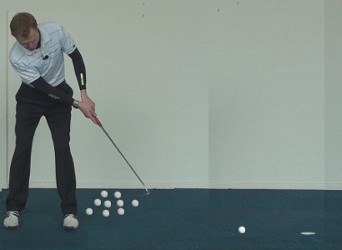
While the old swing axiom “keep your head down” has been widely debunked, it's actually sound advice when it comes to putting. In the full swing, it's literally impossible (and undesirable) to hold your head in the same spot from start to finish. The putting stroke's slow, short motion, on the other hand, means you can maintain a still head throughout.
You should strive to do just that.

Lifting the head as the ball is struck, called “peeking,” is a common problem among golfers – pros included. While it may seem like a minor, harmless flaw, peeking causes the left shoulder to rise, pulling the arms and hands off track. The result is often a poorly struck putt that wiggles right and short of the hole.
Peeking seems like an easy fault to fix, and it is. A little focus will take you a long way, as will this drill. Start with short putts, about three feet from the hole, and progress outward from there.
- Drop 10 balls on the green to be putted from the same spot.
- Hit all 10 using your normal routine and stroke, and note how many you make.
- Starting over from the same point, pick a spot on the back of the ball and focus intently on it.
- As you stroke through the putt and send the ball on its way, make a conscious effort not to move your eyes from their original focus point. You'll now be looking at the green.
- From close range, don't shift your gaze until you hear the ball hit the cup (or until you know it's stopped should you miss). On longer putts, stay focused until the ball is several feet away.
- Compare results of your second set of putts (no peeking) to the first.
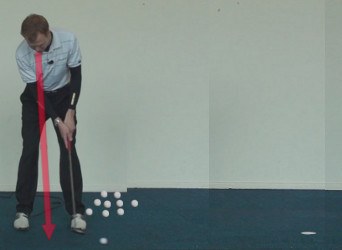
You should notice a decided difference in results when your head remains still. You'll hit the ball more solidly, make more short ones and get the long ones closer, more consistently.
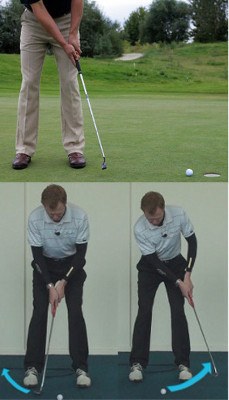
How to Master the No Peek Putting Stroke
Keep your head down. Every golfer has heard those four words at one time or another – in fact, they may be the first four words of golf instruction you ever received. This tip is a good place to start for the beginning golfer because it is so simple. As you swing the club, you keep your head down all the way through impact and into the follow through. If you can accomplish that seemingly simple feat, you will be on your way to an improved game.
Of course, as any experienced golfer knows, it is not always so easy to keep your head down. This is especially true when on the greens. With such a short distance remaining between your ball and the hole, you will be tempted to look up early in order to see whether or not you have been successful with your putt. This is a natural mistake to make, and it is one which has cost amateur golfers countless strokes over the years. If you are going to live up to your potential with the putter, you need to learn how to keep your head down as effectively as possible.
As you can see from the title of this article, we are going to refer to this as the 'no-peek' putting stroke. Obviously, the term no peek refers to the fact that you aren't going to peek up at the hole before the ball has been sent on its way. It will take discipline and plenty of practice to master this putting technique in your own game, but the hard work will be worth it. There is nothing you can do in golf which will have a greater impact on your scores than improving your putting. Master the no peek putting stroke and your scores are going to come down – it is just that simple.
While working on your stroke, it is important that you remember to allow your own personal style to shine through in your technique. Yes, you need to abide by some basic fundamentals – and we will outline those in this article – but you also need to be yourself. If you are too busy trying to conform to a long checklist of techniques, you will never have the natural touch and feel needed to be a great putter. Hit on the basic fundamentals, learn how to keep your head down, and let your natural ability take it from there.
All of the content below is based on a right-handed golfer. If you happen to play left-handed, please take a moment to reverse the directions as necessary.
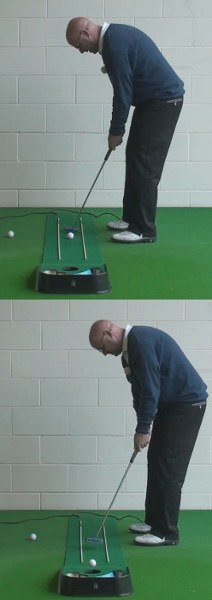
The Benefits of Keeping Your Head Down
Not all golf tips are good tips. If you spend any time hanging around your local driving range or practice putting green, you are sure to hear plenty of tips tossed around by amateur golfers. Some of those tips will be quite helpful – and many of them will be useless. In this case, 'keep your head down' is actually very valuable tip.
But why? The points below highlight just how keeping your head down can benefit your putting stroke.
- Stability through the hit. You need to keep the club moving down the target line all the way through impact when putting. This is relatively easy to do when you keep your head down and still. It gets much harder, however, if you allow your head to lift up and away from the ball as the club swings. Looking up early is going to cause your entire upper body to move, and that means the putter is going to move off of its path as well. In most cases, the putter will be pulled up and to the inside, meaning you will make contact with the ball low on the face, and out toward the toe. In the end, this kind of putt usually comes up short due to the fact that you have missed the sweet spot. The putt may also be off line due to the twisting of the putter face at impact. You already know that it is important to hit the sweet spot when hitting a club like your driver, but you may not have known that this skill is just as important on the greens.
- Simplicity. The best putting strokes are those which are extremely simple from start to finish. When done properly, the putting stroke almost feels a bit silly – it seems like there has to be more to it than there is. This is the 'secret' to great putting. You don't have to do that much in order to achieve excellent results. By just rocking your shoulders back and through, and keeping your head down, you can roll the ball along the green beautifully time after time. Resist the temptation to add unnecessary parts to your putting stroke and keep the whole operation as basic as can be.
- Performance under pressure. When you aren't nervous – say, for example, when you are on the practice green – you might be able to get away with looking up early now and then. There will be no nerves to affect your coordination or timing, so you will be able to guide the ball into the hole even with less-than-perfect technique. Unfortunately, those positive results on the practice green are going to be fool's gold. When you get onto the course, you will start to feel some pressure and the putts that were falling on the practice green will begin to miss. If you are going to putt well under pressure, you need to have rock-solid technique behind you. It should be noted that you don't have to be a tournament player to feel pressure. Even golfers who only play casually will feel pressure when they have a chance to beat a friend or shoot a new personal best score.
- Excellent speed control. Putting is all about controlling your speed. Sure, you need to get the ball on line as well, but your attention should always be first and foremost on controlling the distance that the ball rolls. Even a terrible read will still leave the ball within a couple feet of the hole when you get the speed right. By keeping your head down, you will be able to manage the speed of the putter head more effectively, and your putts should roll a predictable distance as a result. If you have frequently struggled with distance control in your game, there is a good chance you will be able to improve in that area just by keeping your head down.
You will be a better putter if you keep your head down. That isn't a controversial statement, of course, but it is an important point to remember as you practice. During upcoming visits to the practice green, key on keeping your head stable and watch your results quickly improve. Unlike when working on the full swing, you can find improved performance in your putting game after just a brief practice session.

The Three Main Putting Fundamentals
It is easy to let things get complicated in golf. With all of the various instructional outlets available to offer advice, you can quickly overload your brain and get all wrapped up in your technique. Don't let that happen. As mentioned earlier, the best putting strokes are the simple ones.
To help you keep your mind free from too many thoughts, we have outlined the three key putting fundamentals below. All you need to do is focus on these keys when building your stroke and you can be sure that you'll be moving in the right direction.
- Build a stable stance. You need to hold your entire body as still as possible while swinging the putter. With that in mind, creating a stable stance is one of the best things you can do. You should have your feet wider than shoulder width apart, you should have plenty of flex in your knees, and you should be bent comfortably from the waist. If any part of your stance feels uncomfortable or awkward, work on making changes until you are totally comfortable and relaxed. It should be easy to hold your balance throughout the stroke, and you shouldn't feel like you are straining at all. It isn't necessary to make your stance a complete copy of someone else's address position – as long as you are stable and comfortable, you are good to go.
- Use a relaxed grip. This is the putting fundamental which is overlooked more than any other. The average golfer squeezes the grip of the putter tightly at address, which takes feel out of the stroke and makes it harder to swing the club freely. When putting, you want to have a very light grip pressure on the handle of the club. This is going to take the control over the stroke out of your hands and put it into your shoulders, which is exactly where it should be in the first place.
- Use your shoulders to move the club. To go along with the previous point, our last fundamental relates to using your shoulders to rock the club back and through the ball. It is easy to fall into the trap of using your hands and wrists to putt. Unfortunately, such a technique will never lead to consistent results. You will always struggle to control your speed this way, and you will have trouble hitting the line as well. Ditch this method and instead use your shoulders to move the putter back and through. This kind of stroke is simple, repeatable, and reliable under pressure.
That really is just about all you need to know in order to build a great stroke. By using a stable stance, a light grip, and moving the club with your shoulders, most of the hard work will be done. From there, it is simply about practice and repetition in order to teach your body how to feel the right speed for each putt.
The tip of keeping your head down and not peeking up at the hole goes right along with the three fundamentals in this section. Keeping your head down is going to contribute to a repeatable stroke which is simple in its design, and that is exactly what the three tips above are all about as well. It might take you a bit of practice to get comfortable with a no-peek stroke, but you will be amazed at the results once you get on track.
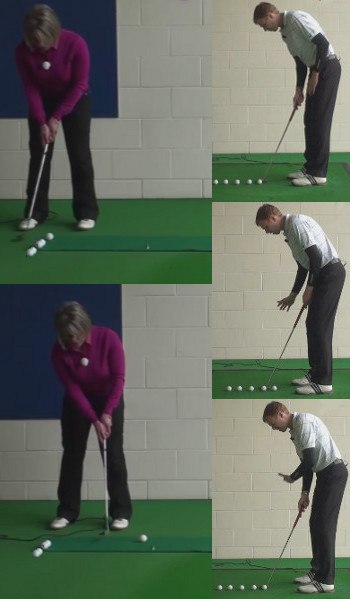
A Couple Easy Drills
To make sure your practice sessions are as productive as possible while trying to learn the no peek stroke, it may be helpful to use a couple of simple drills. The two drills offered in this section are easy to perform, they don't require any special equipment, and they can be completed on any standard putting green. As long as you have a putter and a few golf balls, you are ready to get started.
To perform the first drill, please follow the steps below.
- For this drill, you will need your putter and five golf balls. You will want to find a relatively flat section of green, and you should set the five golf balls down roughly five feet from a hole.
- Prepare for the first putt by reading the green just as you would for any putt during an actual round. Since you picked a flat section of the green, you should be able to aim these putts toward the middle of the cup without any problem.
- Take your stance and prepare to hit the first putt. Align your stance properly, make sure the putter face is aimed correctly down the target line, and make the stroke. When you send the ball on its way, you aren't going to look up – at all. Not even after you have hit the putt. Instead, you are just going to listen. If the ball falls in, you will hear the beautiful sound of the golf ball rattling around in the bottom of the hole. If not, you will hear nothing.
- Without looking up, line up the next ball and make your stroke. Proceed with this pattern until all five balls have been hit. You aren't going to look at the hole at any point during this drill, after the initial setup.
- Once completed, feel free to review the results by looking up at the hole. You will already know how many you made just by listening, but reviewing the results after you are done will show you whether you were missing left or right on the failed putts. Also, you can see if you were hitting the putts too hard or too soft.
This drill is helpful because it will teach you that you don't need to look at the hole in order to make putts. As long as your stroke is in decent shape, you should be able to make at least three or four of the putts even without looking at the cup. During your next round, you will remember these successes and you won't feel as compelled to look up early. In fact, you might find that you like putting this way, and you may wind up just listening for your putts to fall in, even on the course.
In addition to that first drill, we have another one listed below which may be helpful as you continue to work on your no peek stroke.
- Conveniently, the setup for this drill is the same as the first. You can easily transition right into this drill after finishing the one listed above. To repeat, you will need your putter, five golf balls, and a relatively flat section of putting green where you can hit five footers.
- The process for this drill is going to be the same as the one above, except for one major distinction – this time, you are going to hit the putts with your eyes closed. You will want to have your eyes open as you get setup and put the ball in place, but you should then close them before the club starts to swing. Trust your technique to hit a good putt while keeping your eyes closed until after you make contact. Only when the ball has been sent on the way should you open your eyes and reset for the next putt.
- Just as before, you can repeat this drill as many times as you would like. You might be surprised to find that, even with your eyes closed, you still don't see much drop off in your performance. You should still be able to make most of your putts, which will be further proof that you don't need to look up early in order to succeed on the greens.
The goal of these similar drills is to teach you a valuable lesson. Looking up early is not going to do you any good, so you might as well keep your head down. If you can make putts with your eyes closed, after all, you obviously don't need to look up early to watch the ball roll.

Taking the No Peek Stroke to the Course
As is always the case in golf, it might be hard to take this technique with you from the practice green to the course. When on the course, it is natural to revert to your old techniques, no matter how much practice time you have put in to change them. It will take focus and discipline to make sure the changes you made in practice actually show up on the links.
The first thing you can do toward this end is make sure you give yourself a 'soft landing'. The first round you play with your new and improved putting stroke shouldn't be a tournament round. If you put yourself under pressure, you are sure to go back to what makes you comfortable. Play a recreational round by yourself, or with some close friends, so you will feel comfortable enough to stick with your new technique. There will be plenty of time later for more competitive rounds after you have gained confidence in this no peek stroke.
Another tip to keep in mind here is that you need to forgive yourself for some early mistakes. Anytime you try out a new technique on the course, you are bound to be a little bit uncomfortable – and if you are uncomfortable, you may make mistakes. That's okay. You shouldn't expect perfection right from the start. The worst thing you can do is to give up on your new putting stroke just because you missed one or two putts early in the round. Plan on being in this for the long haul and overlook a few early problems.
Finally, you can be helped here by an extra practice stroke before hitting your putts. If you normally make just one practice stroke before a putt, try making two just to reinforce the idea of keeping your head down through impact. This extra practice stroke will only take a few additional seconds, but it could work wonders for your performance. Pretty soon, you will be completely comfortable with your new stroke and you can go back to just one practice stroke, if you so choose.
The no peek putting stroke is a good way to make sure your performance on the greens is living up to its potential. Countless amateur golfers focus all of their practice energy on the driving range when they should really be spending most of their time on the putting green. You can quickly cut strokes off of your average score when you practice your putting, as long as you are working on the right things. Teach yourself to keep your head perfectly still throughout the stroke and you will be going in the right direction. Not only will better putting help you lower your scores, but it may also cause you to feel more confident about your game as a whole. Good luck!





